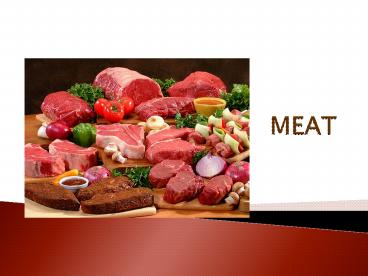MEAT PowerPoint PPT Presentation
1 / 17
Title: MEAT
1
MEAT
2
Meat
- Meat and Meat Products
- Only about 62 of beef is consumed as beef cuts,
24 is ground for hamburger, and 14 is processed
into meat products. - In the case of pork, more than 65 of the total
is consumed in the form of processed meat such as
ham, bacon, and sausage.
3
Meat
- By-products
- cosmetics, glues, gelatins, tallow, variety meat,
bonemeal.
4
Meat
- Traditionally, meatpackers sold carcasses as
sides, quarters (hinds or fores), or as wholesale
cuts (large cuts such as entire rounds, loins,
ribs, or chucks). - Most beef today is sold as Boxed Beef.
5
Meat
- Boxed Beef
- Prepared at the packing plant
- Remove more of the bone and fat
- Cut into smaller portions
- Vacuum-packed to reduce spoilage and shrinkage
- Placed into boxes that are easier to ship and
handle
6
Meat
- Boxed beef reduces shipping costs, labor costs,
and the increased value of the fat and bone to
the packer.
7
Meat
- Government Inspection
- Inspection takes place at practically every step
of the livestock procurement and meatpacking
processes.
8
Meat
- Inspection attempts to ensure
- Harmful additives and ingredients are kept out
of manufactured meat products. - Sick and diseased animals are excluded from the
market. - Misleading labeling and packaging are
eliminated. - Contaminated and unwholesome meats are prevented
from reaching consumers.
9
Meat
- Grading
- Unlike inspection, which is mandatory, meat
grading is a service offered to packers on a
voluntary basis by the Agricultural and Marketing
Service of the USDA. - Grading establishes and maintains uniform
trading standards and aids in the determination
of the value of various cuts of meat.
10
Meat
- Quality grades for beef carcasses are
- Prime
- Choice
- Good
- Standard
- Commercial
- Utility
- Cutter
- Canner
11
Meat
- These grades are assigned on the basis of
- Marbling
- Color and Texture
- Maturity
12
Meat
- Slaughtering Practices
- The Humane Slaughter Act of 1960 requires that
prior to slaughter, animals be rendered
completely unconscious with a minimum of
excitement and discomfort, by mechanical,
electrical, or chemical methods.
13
Meat
- Bled
- Skinned
- Eviscerated
- Chilled
- Graded
- Processed
14
Meat
- Meat items, such as
- Brains
- Kidneys
- Sweetbreads
- Tail
- Tongue
- do not accompany a carcass and are considered
the by-products.
- These parts, and all other items removed from the
carcass, such as - Feet
- Hide
- Intestines
- are called offal and are an important source of
income for meatpackers.
15
Meat
- Chilling
- Immediately after slaughter, many changes take
place in muscle that convert muscle to meat.
16
Meat
- Rigor Mortis
- One of the changes is the contraction and
stiffening of muscle known as rigor mortis. - Muscle becomes progressively less tender until
rigor mortis is complete.
- BEEF
- 6 12 Hours
- Pork
- 1 6 Hours
17
Meat
- Cold Shortening
- The carcass is chilled immediately after
slaughter to prevent spoilage. - If the carcass is chilled too rapidly, the
result is cold shortening and subsequent
toughness. - Occurs when the muscle is chilled to less than
60o F before the completion of rigor mortis.

